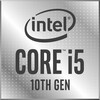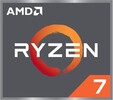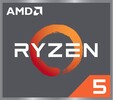Intel Core i7-10510U vs AMD Ryzen 7 3780U vs AMD Ryzen 5 3580U
Intel Core i7-10510U
► remove from comparison
The Intel Core i7-10510U is a power efficient quad-core SoC for notebooks based on the Comet Lake (CML-U) generation and was announced in August 2019. Compared to the similar Whiskey Lake processors (e.g.& Core i7-8665U), the only difference is support for higher memory speeds (DDR4-2666, LPDDR4-2933) and two additional cores in the top model (not in this i7-10510U). The processor cores are clocked between 1.8 and 4.9 GHz (all 4 cores 4.3 GHz max). Thanks to HyperThreading 8 threads can be used. More information on Comet Lake and all the models and articles on it can be found here.
The integrated graphics adapter however is still the same as in the previous generations. It should be still called Intel HD Graphics 620 and clock from 300 - 1150 MHz in the i7. Furthermore, the SoC integrates a VP9 and H.265 de- and encoder and an integrated dual channel DDR4-2666 / LPDDR4-2933 memory controller.
Performance
The average 10510U in our database proves to be an OK mid-range option, its multi-thread benchmark scores hovering near those of the Ryzen 7 2700U and the Core i5-8259U. While not as impressive as the hexa-core Core i7-10710U, the 10510U will make most customers happy, making for short load times and generally pain-free experience.
Thanks to its decent cooling solution and a long-term CPU power limit of 45 W, the Modern 15 A10RB is among the fastest laptops powered by the 10510U that we know of. It can be more than twice as fast in CPU-bound workloads as the slowest system featuring the same chip in our database, as of August 2023.
Power consumption
This Core i7 series chip has a default TDP (also known as the long-term power limit) of 15 W, a value that laptop makers are free to change to anything between 10 W and 25 W resulting in corresponding performance and clock speed changes. By going for the lowest value, it is possible to build passively cooled tablets, laptops, mini-PCs around the i7. Please note that Comet Lake-U chips can briefly consume up to 90 W when under extreme loads.
Last but not the least, the i7-10510U is built with one of the old 14 nm Intel processes for lower-than-average, as of late 2022, energy efficiency.
AMD Ryzen 7 3780U
► remove from comparison
The AMD Ryzen 7 3780U,a Microsoft Surface edition chip, is a mobile SoC that was announced in Oct 2019 as part of the new Surface Laptop 15. It combines four Zen+ cores (8 threads) clocked at 2.3 - 4 GHz with a Radeon RX Vega 11 graphics card with 11 CUs (704 Shaders) clocked at up to 1400 MHz. Specified at 15 Watt TDP, the SoC is intended for thin mid-range laptops.
Compared to the similar Ryzen 7 3700U, the 3780U offers the faster Vega 11 instead of the Vega 10 GPU.
The Picasso SoCs use the Zen+ microarchitecture with slight improvements that should lead to a 3% IPC (performance per clock) improvements. Furthermore, the 12nm process allows higher clock rates at similar power consumptions.
The integrated dual-channel memory controller supports up to DDR4-2400 memory. As the features of the Picasso APUs are the same compared to the Raven Ridge predecessors, we point to our Raven Ridge launch article.
Performance
While we have not tested a single system powered by the 3780U as of August 2023, it's safe to expect the chip to be about as fast as the Ryzen 7 3700U, as far as multi-thread performance is concerned.
AMD Ryzen 5 3580U
► remove from comparison
The AMD Ryzen 5 3580U, a Microsoft Surface Edition chip, is a mobile SoC that was announced in October 2019 as part of the Surface Book 15. It combines four Zen+ cores (8 threads) clocked at 2.2 - 3.8 GHz with a Radeon RX Vega 9 graphics adapter with 9 CUs (576 Shaders) clocked at up to 1300 MHz. Compared to the similar Ryzen 5 3500U, the 3580 integrates a faster GPU with 9 instead of 8 CUs.
The Picasso SoCs use the Zen+ microarchitecture with slight improvements that should lead to a 3% IPS (performance per clock) improvements. Furthermore, the 12nm process allows higher clock rates at similar power consumptions.
The integrated dual-channel memory controller supports up to DDR4-2400 memory. As the features of the Picasso APUs are the same compared to the Raven Ridge predecessors, we point to our Raven Ridge launch article.
Performance
The average 3580U in our extensive database is in the same league as the Core i5-1035G7 and also the Core i7-10510U, as far as multi-thread benchmark scores are concerned. This is a fairly decent result, as of mid 2021.
Power consumption
This Ryzen 5 has a default TDP (also known as the long-term power limit) of 15 W, a value that laptop manufacturers - or should we say, Microsoft - are allowed to change to anything between 12 W and 35 W with clock speeds and performance changing correspondingly. Those values are not low enough to allow for fan-free designs, for better or worse.
The CPU is built with a fairly old, as of late 2022, 12 nm process for lower-than-average energy efficiency.
| Model | Intel Core i7-10510U | AMD Ryzen 7 3780U | AMD Ryzen 5 3580U | ||||||||||||||||||||||||||||||||||||||||||||||||||||||||||||||||||||||||||||||||||||||||
| Codename | Comet Lake-U | Picasso-U (Zen+) | Picasso-U (Zen+) | ||||||||||||||||||||||||||||||||||||||||||||||||||||||||||||||||||||||||||||||||||||||||
| Series | Intel Comet Lake | AMD Picasso (Ryzen 3000 APU) | AMD Picasso (Ryzen 3000 APU) | ||||||||||||||||||||||||||||||||||||||||||||||||||||||||||||||||||||||||||||||||||||||||
| Series: Picasso (Ryzen 3000 APU) Picasso-U (Zen+) |
|
|
| ||||||||||||||||||||||||||||||||||||||||||||||||||||||||||||||||||||||||||||||||||||||||
| Clock | 1800 - 4900 MHz | 2300 - 4000 MHz | 2100 - 3700 MHz | ||||||||||||||||||||||||||||||||||||||||||||||||||||||||||||||||||||||||||||||||||||||||
| L1 Cache | 256 KB | 384 KB | 384 KB | ||||||||||||||||||||||||||||||||||||||||||||||||||||||||||||||||||||||||||||||||||||||||
| L2 Cache | 1 MB | 2 MB | 2 MB | ||||||||||||||||||||||||||||||||||||||||||||||||||||||||||||||||||||||||||||||||||||||||
| L3 Cache | 8 MB | 4 MB | 4 MB | ||||||||||||||||||||||||||||||||||||||||||||||||||||||||||||||||||||||||||||||||||||||||
| Cores / Threads | 4 / 8 | 4 / 8 | 4 / 8 | ||||||||||||||||||||||||||||||||||||||||||||||||||||||||||||||||||||||||||||||||||||||||
| TDP | 15 Watt | 15 Watt | 15 Watt | ||||||||||||||||||||||||||||||||||||||||||||||||||||||||||||||||||||||||||||||||||||||||
| Technology | 14 nm | 12 nm | 12 nm | ||||||||||||||||||||||||||||||||||||||||||||||||||||||||||||||||||||||||||||||||||||||||
| max. Temp. | 100 °C | 105 °C | 105 °C | ||||||||||||||||||||||||||||||||||||||||||||||||||||||||||||||||||||||||||||||||||||||||
| Socket | BGA1528 | FP5 | FP5 | ||||||||||||||||||||||||||||||||||||||||||||||||||||||||||||||||||||||||||||||||||||||||
| Features | LPDDR3-2133/DDR4-2666/LPDDR4-2933 RAM, PCIe 3, 4 GT/s bus, MMX, SSE, SSE2, SSE3, SSSE3, SSE4.1, SSE4.2, AVX, AVX2, BMI2, ABM, FMA, ADX, VMX, SMEP, SMAP, MPX, EIST, TM1, TM2, Hyper-Threading, Turbo, SST, AES-NI, RDRAND, RDSEED, SGX | DDR4-2400 RAM, PCIe 3, MMX (+), SSE, SSE2, SSE3, SSSE3, SSE4.1, SSE4.2, SSE4A, AES, AVX, AVX2, FMA3, SHA | DDR4-2400 RAM, PCIe 3, MMX (+), SSE, SSE2, SSE3, SSSE3, SSE4.1, SSE4.2, SSE4A, AES, AVX, AVX2, FMA3, SHA | ||||||||||||||||||||||||||||||||||||||||||||||||||||||||||||||||||||||||||||||||||||||||
| iGPU | Intel UHD Graphics 620 (300 - 1150 MHz) | AMD Radeon RX Vega 11 ( - 1400 MHz) | AMD Radeon RX Vega 9 ( - 1300 MHz) | ||||||||||||||||||||||||||||||||||||||||||||||||||||||||||||||||||||||||||||||||||||||||
| Architecture | x86 | x86 | x86 | ||||||||||||||||||||||||||||||||||||||||||||||||||||||||||||||||||||||||||||||||||||||||
| Announced | |||||||||||||||||||||||||||||||||||||||||||||||||||||||||||||||||||||||||||||||||||||||||||
| Manufacturer | ark.intel.com | www.amd.com | www.amd.com | ||||||||||||||||||||||||||||||||||||||||||||||||||||||||||||||||||||||||||||||||||||||||
| Transistors | 4500 Million | 4500 Million |
Benchmarks
Average Benchmarks Intel Core i7-10510U → 100% n=6
Average Benchmarks AMD Ryzen 7 3780U → 91% n=6
Average Benchmarks AMD Ryzen 5 3580U → 87% n=6
* Smaller numbers mean a higher performance
1 This benchmark is not used for the average calculation













